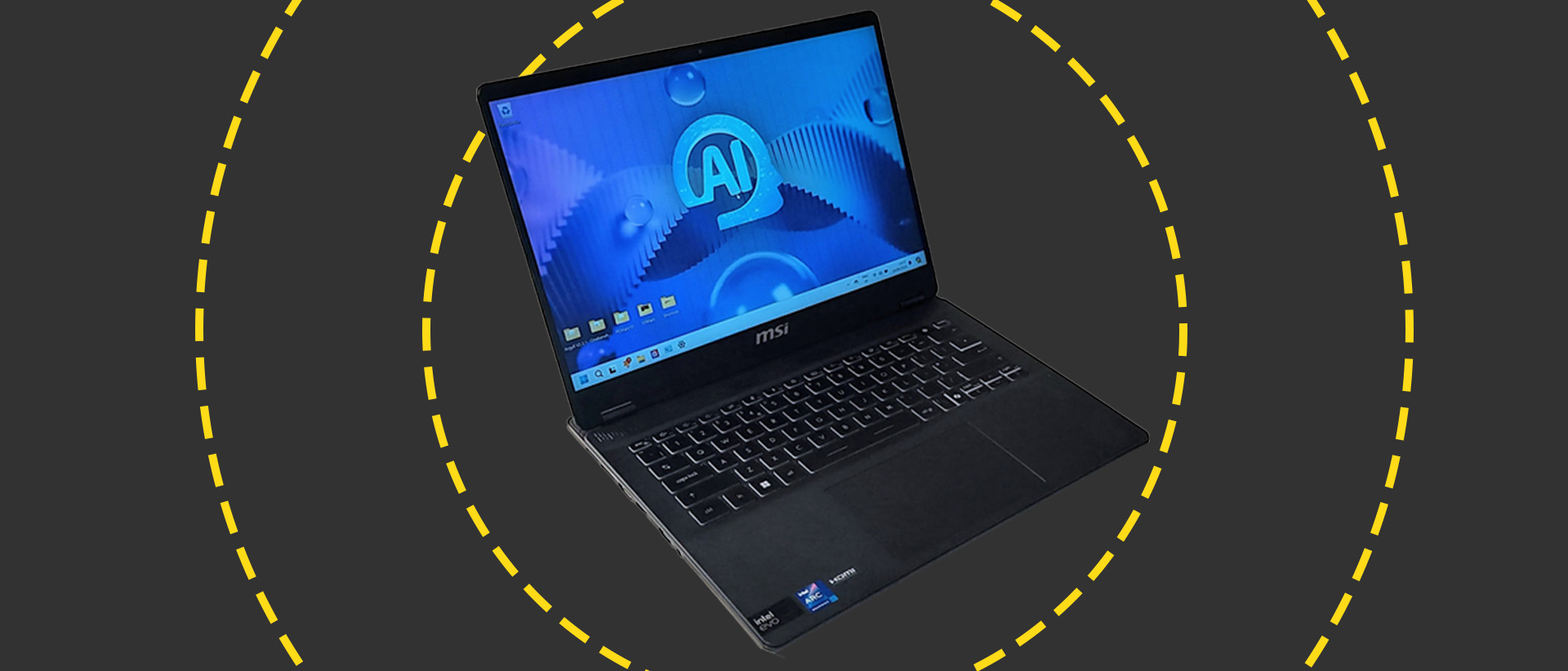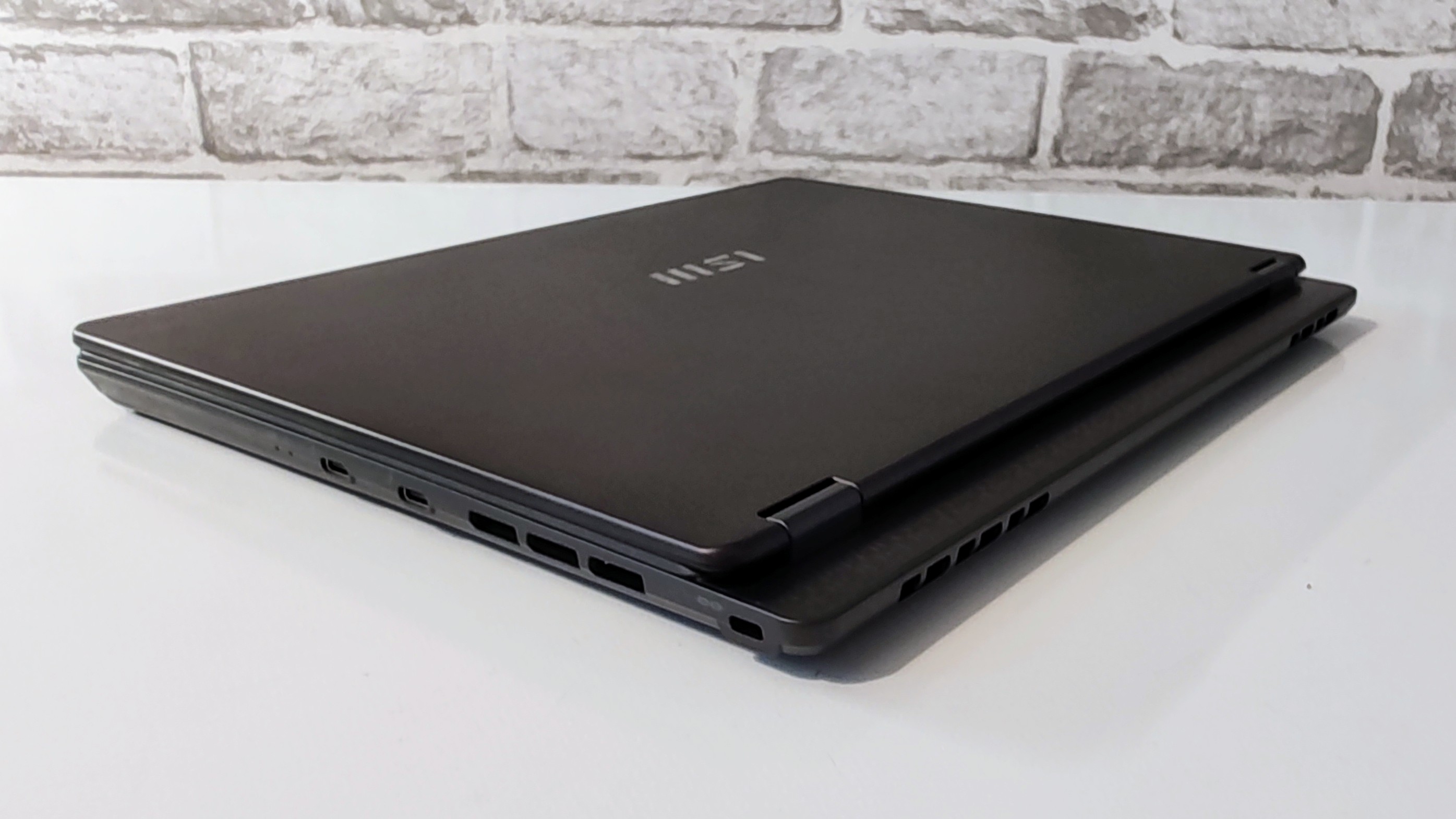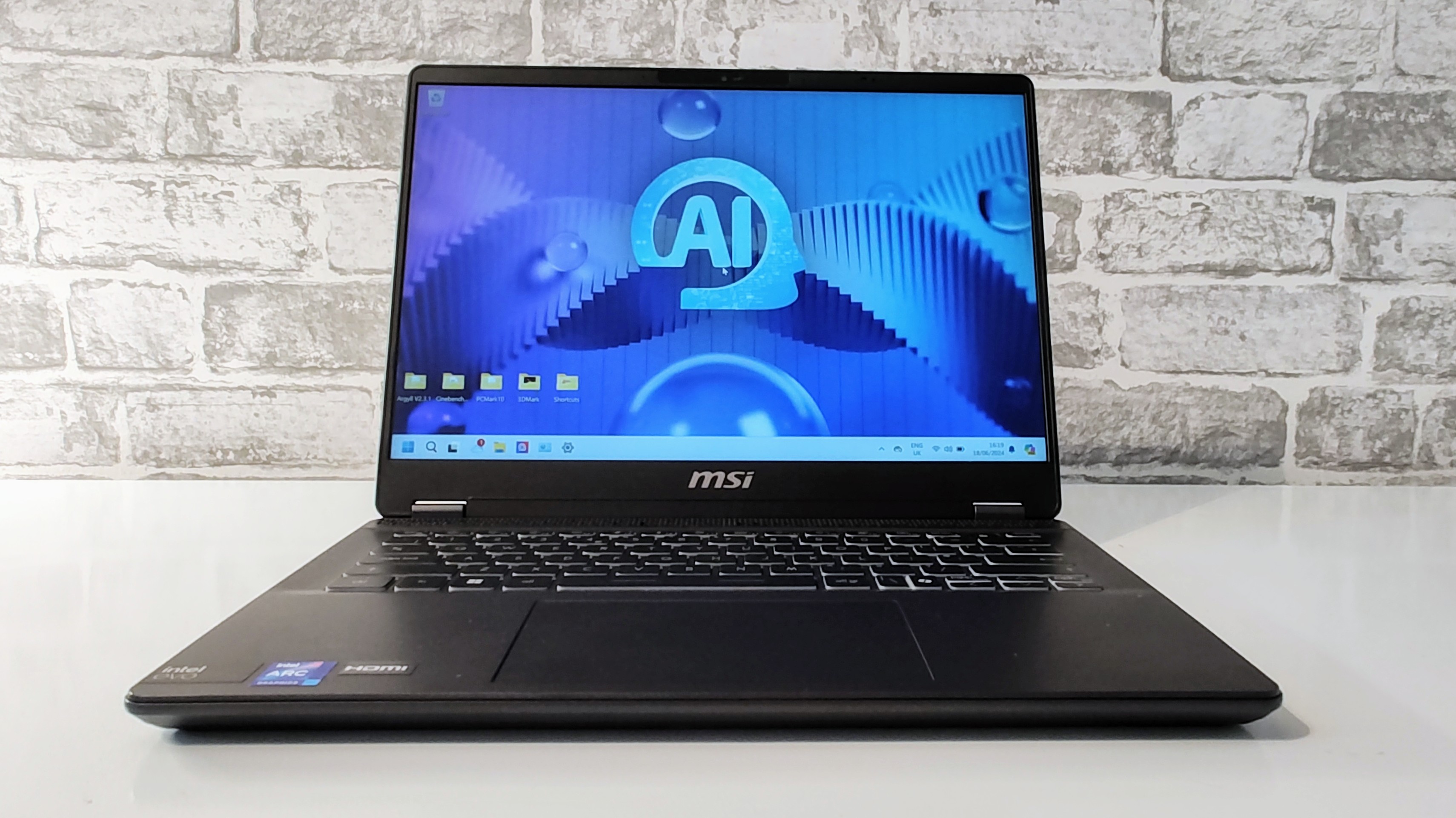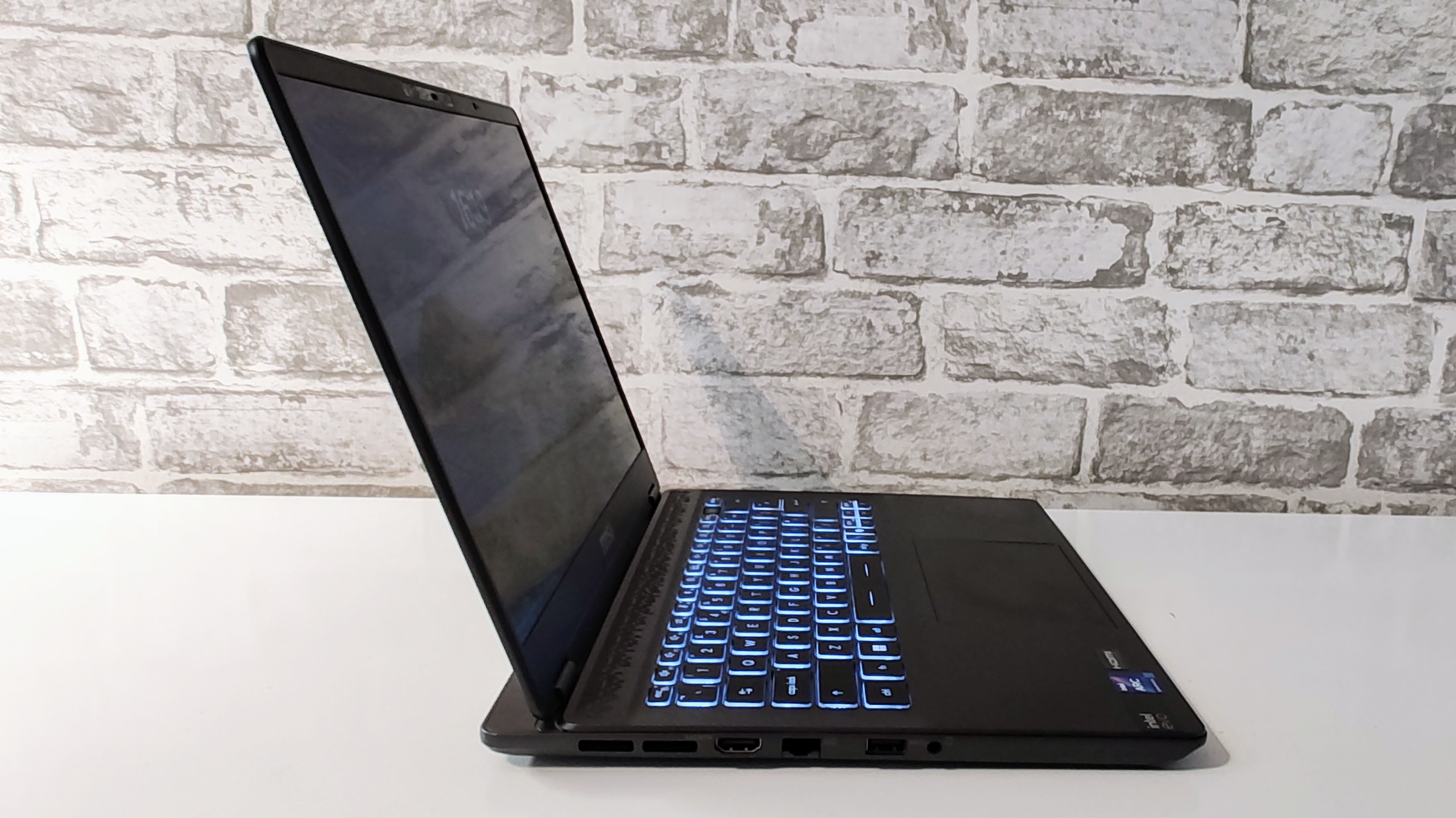MSI Prestige 14 AI Evo C1M review: The essence of a modern business laptop
Great battery life, cutting-edge wireless comms, and a 144hz display mark this business compact out from the herd

-
+
Bright 144Hz screen
-
+
Excellent battery life
-
+
Wi-Fi 7 & Bluetooth 5.4
-
+
Two Thunderbolt 4 ports
-
-
The base panel is difficult to remove
-
-
Type-C ports are poorly positioned

MSI's Prestige compact laptops have long been stalwarts of the business world. We tested a model with an RTX 3050 GPU back in August of 2022 and were rather impressed, despite the poor battery life blighted proceedings.
For 2024 the Prestige 14 has become the Prestige Evo AI, an inevitable change in nomenclature given that everything, his wife and their god is now being labelled "AI". The AI part of the proceedings is arguably the least interesting given that it's common to all laptops running Windows 11 with Copilot on Meteor Lake Core Ultra processors. Thankfully there are several more interesting features of the new Prestige 14.
MSI Prestige 14 AI Evo: Design
In common with most laptops pitched at the business user, the Prestige 14 AI Evo is visually a rather mundane affair available in one color which MSI calls Stellar Gray. At 313.4 x 246.5mm and just under 19mm thick the Prestige 14 is quite compact for a laptop with a 14in 16:10 display.
The lip that projects beyond the lid hinge (a 180-degree affair) is a new feature for an MSI business laptop and may have something to do with the unusually capacious battery that MSI has squeezed inside.
At 1.7Kg the Prestige 14 is not exactly a featherweight (again, the larger battery may be to blame) but it's still light enough to be easily carried about in a backpack or briefcase and the accompanying USB power supply is both light and compact.
The Prestige 14 is made mainly from aluminum and boasts a MIL-STD-810H rating meaning it should resist shocks, particle ingress, and extremes of temperature. It feels solid and well-made with little flex evident in either the lid or keyboard deck unless you get deliberately brutal with it.
We've no issue with the number or type of ports that the Prestige 14 houses: Two Thunderbolt ports, a 10Gbit/sec USB-A port, Gigabit Ethernet, HDMI 2.1, and a 3.5mm audio port is a solid enough selection, but the layout is a little less than ideal.

We've no issue with the left side which houses the USB-A, Ethernet, HDMI, and audio jacks but on the right, both Type-C ports are situated amidships and one of them is often occupied with the 100W charger. If you have both Type-C ports in use then using a separate mouse with your left hand becomes difficult. One Type-C on each side and at the back would be a much happier arrangement.
Wireless communications are as up-to-date as possible with the Killer BE1750 card supporting both ultrafast Wi-Fi 7 and Bluetooth 5.4 which promises greater range, stronger connections, enhanced smart home and IoT capabilities, and improved audio quality.
According to MSI, the Prestige 14 can house two SSDs and two SODIMM RAM cards but we couldn't get my review unit open to check on that claim. We managed to get the clips around the front and sides to separate but after that, the only option was to apply more force than we were comfortable doing.
Press offices tend to get a bit miffed if you send a sample in more pieces than it arrived so we didn't press the issue. In short, you can upgrade the Prestige 14 with more storage and RAM, but it's probably best to let a professional do it.
RELATED WHITEPAPER

Security is naturally a priority for a business laptop so the Prestige features Windows Hello IR facial recognition as well as a fingerprint scanner built into the power button. You also get a physical webcam shutter and a Kensington lock along with discrete Trusted Platform Module (dTPM) 2.0 and Firmware Trusted Platform Module (fTPM) 2.0.
Also preloaded is the Tobii Aware software suite which includes a raft of productivity, welfare, and security options such as blurring the display when the camera notices someone looking over your shoulder or you look away or leave your desk.
MSI Prestige 14 AI Evo: Keyboard, touchpad, and webcam
Being a compact laptop the Prestige 14's keyboard is not the most expansive you'll ever encounter. Naturally, there's no numeric keyboard but the fiddly half-height cursor keys and half-width Copilot keys are a little less to forgive, especially given that previous generation Prestige 14s had full-sized cursor keys.
The keys themselves have a clean and positive action and plenty of travel while the keycap graphics are models of clarity with or without the 3-level white backlight engaged.
At 120 x 75mm the touchpad is just a little on the small side; it could easily have been made both wider and deeper, but it works well though the click-action is just a little too loud to pass my getting-dirty-looks-in-a-library-while-typing test.
The webcam image was rather fuzzier than we expected given the 1080p video capture but images were impressively bright even in low-light environments and the color balance was good. MSI's AI Noise Cancellation performed well too, cutting out background noise to an impressive degree.
MSI Prestige 14 AI Evo: Display
The 14in 1,920 x 1,200 IPS panel may look a little mundane at first glance as the specification sheet but it has a few tricks up its sleeve. Firstly, it has a 144Hz refresh rate, making screen animations noticeably smoother than on a normal 60Hz display, and it's usefully bright, maxing out at 493cd/m2.
We usually reserve using the various Blur Buster's motion tests for gaming laptops or models aimed at creatives with 90 or 120Hz screens but we couldn't pass up the chance to try them on the new MSI. The results were spectacular with very little ghosting or smearing in evidence. In practical terms, it makes scrolling through spreadsheets a far more visually satisfying experience than on a standard 60Hz screen.

It's not the most colorful panel we've ever come across with gamut volumes of 95.4% sRGB, 67.7% DCI-P3, and 65.7% Adobe RGB but for a productivity laptop that is sufficient. Measured against the sRGB profile the screen's Delta E accuracy scored 1.8 which is more than acceptable with any variance being undetectable other than to the highly-trained eye or colorimeter.
Thanks to that solid maximum brightness the screen's contrast ratio was a good 1233:1 though in the absence of any sort of HDR certification, you can't view HDR content as the makers intended.
MSI Prestige 14 AI Evo: Specs and Performance
The new prestige is available with Core Ultra 5, 7, and 9 processors along with Intel's new integrated Arc graphics solution. Our test machine was the runt of the litter chip-wise with the 14-core Ultra 5 125H chip which features 4 performance cores, 8 efficient cores, and two low-power efficient cores.
The chipset also includes Intel's AI Boost neural processor to take care of background AI tasks like running the webcam effects contained in the Windows Studio Effects suite. The on-paper AI performance falls short of the new Copilot+ machines built around Qualcomm's Snapdragon X Elite SoC but at the moment we don't see that having much impact on the overwhelming majority of users.
Despite being the weakest CPU in the range by review unit did well scoring 243 points in our in-house 4K multi-media benchmark, 6,095 in the PCMark10 test, and 12,576 in the Cinebench R23 multi-core test. Those are some very decent results from a relatively low-power chip.
Those numbers also mean that the new MSI enjoys a performance advantage over the likes of the Lenovo ThinkPad E16 and Asus Zenbook S13 which both swim in similar waters.
Intel's latest Arc iGPU is a big step forward from the Iris Xe and UHD graphics models and is even capable of low-detail 3D gaming. The Arc iGPU scored 27,491 in the GeekBench 5 OpenCL test, a 25% improvement on the sort of score we'd expect from an Xe chip, despite having one less core than the version used in the Core 7 155H and Core 9 185H chipsets.
It's important not to expect too much though as the Prestige Evo 14 still only managed to run the SPECviewperf 3dsmax 3D modeling test at 14fps, massively lower than the 60-70fps you'd get from even a low-TGP Nvidia RTX4050-based system.

The 1TB Samsung SSD performed well with average sequential read and write speeds of 5,450MB/s and 4,398MB/s respectively. This makes moving bulky data files on and off the Prestige an impressively quick affair.
Where the Prestige 14 brings the bacon home is in battery life. A full charge of the 90Wh battery lasted for 13 hours 15 minutes in our video rundown test which is a very strong showing for a Windows x86 machine. Recharge time is good too with the battery showing 52% capacity after 30 minutes plugged in.
MSI Prestige 14 AI Evo: Is it worth it?
Looking at some popular retail sites you can pick up the Core Ultra 5 model of the Prestige 14 AI EV for £999 inc VAT including a £100 discount and the Core Ultra 7 model for £1,049 inc VAT including a £250 discount. At present the Core Ultra 9 models seem only to be available in the USA.
Given those prices you have to get seriously picky to criticize the new Prestige Evo 14 AI because it has all the basics very well covered. The bright 144Hz display is more than you have any right to expect at this price as is the standard 1TB SSD and cutting-edge wireless card while the efficient but potent CPU and high-capacity battery means you won't be forever hunting for a power point.
The positioning of the two Type-C ports isn't ideal in our opinion and given the upgrade options it should be easier to access the inside. It wouldn't go amiss to offer more colorways besides plain grey either. Those are relatively minor niggles though and do absolutely nothing to knock the shine off MSI's very impressive new business compact.
MSI Prestige Evo 14 AI specs
| Display | 14-inch 1,920 x 1,200 IPS, 144Hz refresh rate |
| Processor | Intel Core Ultra 5 125H |
| GPU | Intel Arc iGPU |
| RAM | 16GB |
| Ports | Thunderbolt 4 x 2, USB-A 3.2 Gen 2 x 1, HDMI 2.1 x 1, RJ-45 Ethernet |
| 3.5mm audio jack | Yes |
| Camera | 1080p webcam with Windows Hello IR facial recognition |
| Storage | 1TB PCIe4 SSD |
| Connectivity | Wi-Fi 7 (802.11be), Bluetooth v5.4 |
| Weight | 1.7Kg |
| Dimensions | 313.4 x 246.5 x 18.95mm |
| Battery Capacity | 90Wh |
| Operating System | Windows 11 Home |
Get the ITPro daily newsletter
Sign up today and you will receive a free copy of our Future Focus 2025 report - the leading guidance on AI, cybersecurity and other IT challenges as per 700+ senior executives
Over the years, Alun has written freelance for several online publications on subjects ranging from mobile phones to digital audio equipment and PCs and from electric cars to industrial heritage. Before becoming a technology writer, he worked at Sony Music for 15 years. Quite what either occupation has to do with the degree in Early Medieval History he read at the University of Leeds is a bit of a grey area. A native of Scotland but an adopted Mancunian, Alun divides his time between writing, listening to live music, dreaming of the glens and dealing with an unhinged Norwegian Elkhound. For ITPro, Alun reviews laptops and PCs from brands such as Acer, Asus, Lenovo, Dell and HP.
-
 Ransomware attacks are rising — but quiet payouts could mean there's more than actually reported
Ransomware attacks are rising — but quiet payouts could mean there's more than actually reportedNews Ransomware attacks continue to climb, but they may be even higher than official figures show as companies choose to quietly pay to make such incidents go away.
By Nicole Kobie Published
-
 Google tells some remote workers to return to the office or risk losing jobs
Google tells some remote workers to return to the office or risk losing jobsNews Google has warned remote workers will need to return to the office or else lose their jobs, according to reports.
By Ross Kelly Published
-
 IBM puts on a brave face as US government cuts hit 15 contracts
IBM puts on a brave face as US government cuts hit 15 contractsNews Despite the cuts, IBM remains upbeat after promising quarterly results
By Nicole Kobie Published